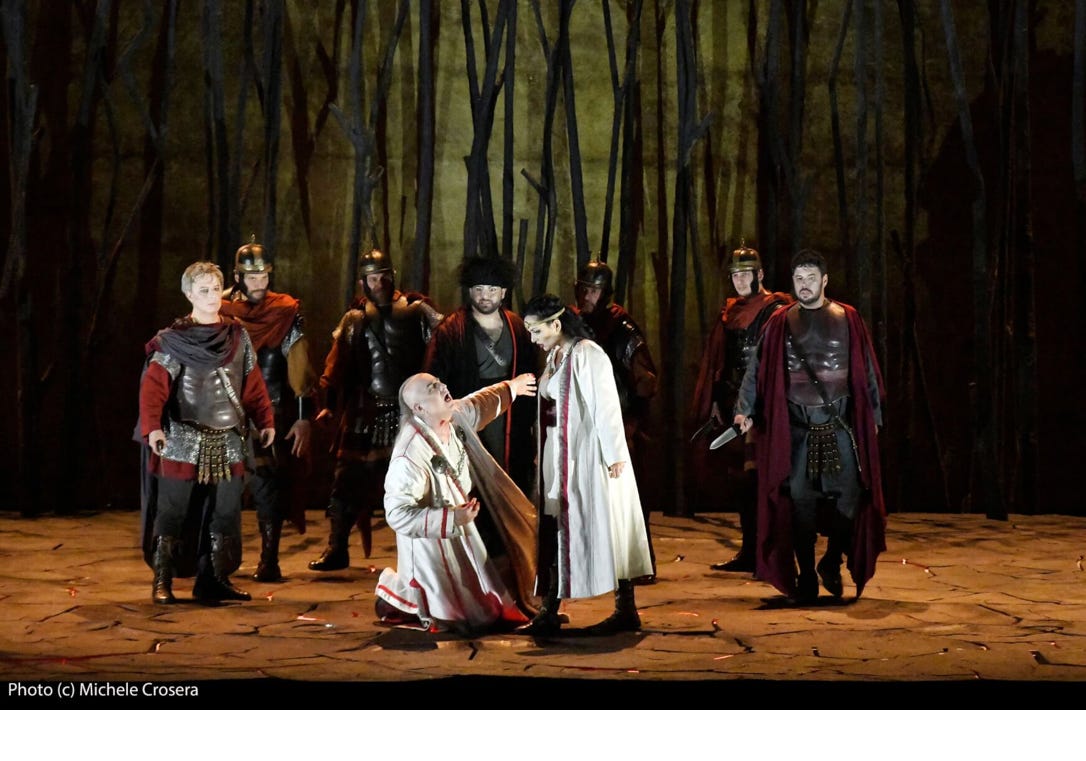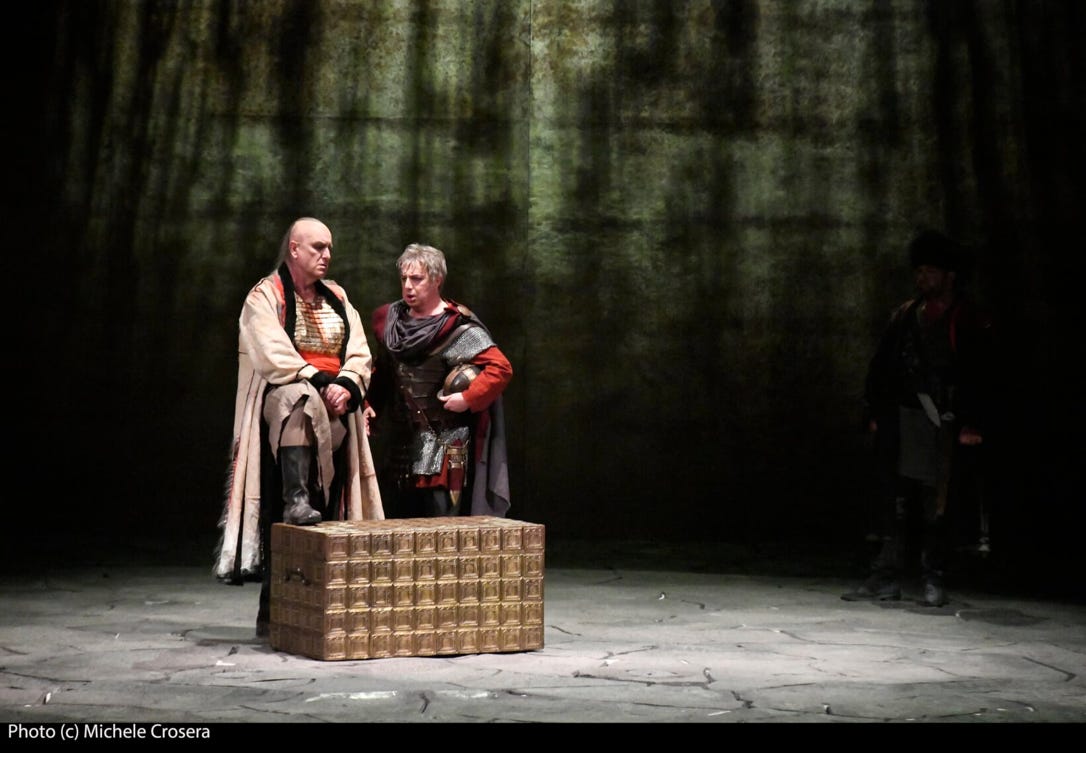Final Scene: Foreground (left to right) Vladimir Stoyanov (Ezio), Michele Pertusi (Attila) Anastasia Bartoli (Odabella) Antonio Polo (Foresto)
This is an edited version of a review which first appeared in Oper! Magazin in Jan Geisbusch’s German translation. It is republished here, free for all to read, by kind permission of Oper!’s editor, Dr. Ulrich Ruhnke
It is not only for reasons of nostalgia that Venice’s Teatro La Fenice makes something of a speciality of Verdi’s Attila, first seen there in 1848. It is one of five operas Verdi created for this address (the others being Ernani, Rigoletto, La traviata and the first version of Simon Boccanegra), and although it appears less frequently on the programme than Rigoletto and La traviata, it has still notched up five productions in the last 50 years. For an early Verdi rarity barely seen anywhere before the 1950s, one staging per decade is an impressive chunk of performance history, especially with exponents ofthe bass title role as starry as Boris Christoff (1975) and Samuel Ramey (1986 and 1987).
The theatre’s latest staging showcased a mixture of veterans and relative newcomers. The former includedstalwart Italian bass Michele Pertusi in the title role (which he last sang in Venice in 2004) and, as Ezio, Bulgarian baritone Vladimir Stoyanov, who has studied and worked in Italy for the best part of a quarter-century. The younger generation was represented by the Odabella of Italian diva Anastasia Bartoli, already something of a cult soprano at Pesaro’s Rossini Festival and garnering an international reputation with more familiar early Verdi roles; and by the tenor Antonio Poli (Foresto), who came to notice more than a decade ago as a bright-voiced Fenton (in Bari) and in several Mozart roles, before moving into lirico-spinto roles.
Avrai tu l’universo, resti l’Italia per me: Pertusi (Attila) Stoyanov (Ezio)
Pertusi and Stoyanov are known quantities in this kind of repertoire and are still able to deliver convincing vocal performances, though both are now betraying signs of long service as Verdian foot-soldiers. Pertusi sings his native language most eloquently, and his stage persona exudes absolute authority as the notorious invading Hun, while Stoyanov’s command of Italian means that the famous line in their opening duet (“Avrai tu l’universo, resta l’Italia per me”) resonates powerfully with the audience - as it has since the premiere, even if critics down the years have been less sympathetic to the opera as a whole - the Act Three denouement, with Odabella assassinating Attila at their wedding always strikes me as perfunctory.
Bartoli’s soprano is an exciting instrument, with a raw-metallic cutting edge somewhat reminiscent of the later years of Renata Scotto. As the warrior princess Odabella, she held nothing back in terms of vocal and emotional commitment. Occasionally this translated into sounds that could be regarded as reckless but, with courage to spare(and hopefully more flatteringly costumed than she was here), Bartoli will be fascinating to watch as she progresses to the more formidable challenges of Abigaïlle (Nabucco) and Lady M (Macbeth). Poli is a less spontaneous artist, but his tenor is a sturdy instrument which he uses with nuance and subtlety.
Odabella prepares for her murderous wedding: Bartoli
These principal singers were routinely served by conductor and production team. Under Sebastiano Rolli, a bandmasterly maestro, the Fenice’s choral and orchestra forces experienced moments of uncertainty at this fourth performance. As for Leo Muscato’s rudimentary staging, it was draped in minimalist stage pictures by Federica Parolini and all-purpose historical costumes by Silvia Aymonimo - the same team which, with Alessandro Verrazzi’s lighting, gave us La Scala’s more elaborate if scarcely more illuminating season-opener La Forza del destino in December. For Attila Verrazzi supplied a couple of moderately spectacular thunder-and-lightning displays,which broke the conventional thrust of Muscato’s story-telling and the cast’s semaphoric arm-movements. But as an interpretation of the youthful Verdi’s political theatre, this was lame stuff: you would never have guessed (if you hadn’t read the programme essays) that Attila derives from a (long-forgotten) German play with references to Wodan and other Pagan Nordic deities.
Attila clearly has an honoured place in the repertoire of this historic theatre but, given the less than propitious conducting and stagecraft on display here, the post-bel canto style of Verdi’s early career would be better represented at La Fenice by Ernani or, even more so, the Ur-Boccanegra, his final opera for Venice, almost a decade later.
Cast and Creatives
Attila Michele Pertusi Ezio Vladimir Stoyanov Odabella Anastasia Bartoli Foresto Antonio Poli Uldino Andrea Schifaudo Leone Francesco Milanese
Conductor Sebastiano Rolli Director Leo Muscato Sets Federica Parolini Costumes Silvia Aymonimo Lighting Alessandro Varazzi Chorus Master Alfonso Caiani
Performance attended 22 May, 2025
Website: teatrolafenice.it






